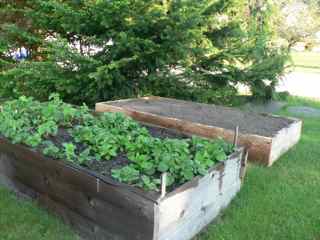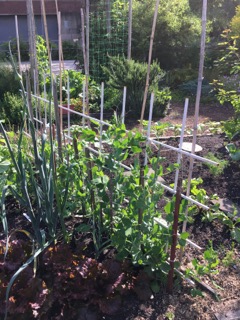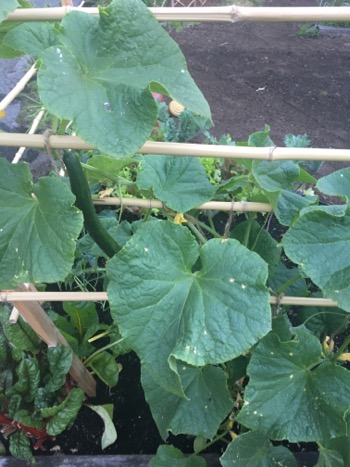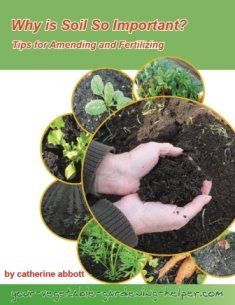10 Tips for small space vegetable gardening
Do you live in a small space? My tips for small space vegetable gardening can help if you are short in space.
We can all grow and enjoy our own fresh vegetables no matter where we live. You can use a balcony, window ledge, porch or even a rooftop to grow some excellent veggies. These small space gardening tips will help you maximize your space and create a flourishing garden.
1. Emphasize vertical crops
One of the best ways to save space is to think vertically. Use walls, railings, and fences to grow plants upwards rather than outwards. Vertical gardening options include:
Trellis and Arbors: Ideal for climbing plants like tomatoes, cucumbers, or beans.
Hanging Planters: Great for flowers, herbs, or small vegetables.
Vertical Garden Kits: These are stackable or wall-mounted containers designed to hold multiple plants.
Stakes: Check out different ways I stake my veggies.
2. Choose the Right Plants
Selecting plants that thrive in small spaces is essential. Focus on:
Compact Varieties: Many vegetables, fruits, and flowers come in smaller varieties designed specially for container gardening. Look for terms like "dwarf," "compact" or "bush" on seed packets.
Fast-Growing Herbs: Basil, cilantro, chives and parsley grow well in pots and are useful in the kitchen.
Leafy Greens: Spinach, lettuce, and kale are perfect for small spaces and can even be grown in shallow containers.
3. Container Gardening
Containers allow flexibility ans are a great wasy to grow a wide variety of plants in small spaces. Here's what to keep in mind:
Pot Size: Ensure your containers are deep enough for your plants' root systems. Root vegetables need deeper pots, while herbs and lettuce can thrive in shallower ones.
Drainage: Always choose containers with drainage holes to avoid waterlogged roots.
Portable Planters: Consider using pots with wheels or that are lightweight enough to move easilly. This allows you to adjust the placement of your plants to get optimal sunlight throughout the day.
4. Maximize Light Exposure
Sunlight is a key factor for plant growth, but is can be challenging to find in small spaces. Optimize light exposure by:
Tracking the Sun: Monitor how sunlight moves through your space during the day, and arrange plants where they will receive adequate light.
Use Reflective Surfaces: Position mirrors of light-coloured surfaces near plants to reflect more sunlight onto them.
Grow Lights: If your space doesn't get enough natural light, especially indoors, invest in grow lights to supplement.
5. Use Raised Beds or Pallet Gardens
If you have a small yard or patio, raised beds are an excellent option to create well-defined growing areas. Alternatively, wooden pallets can be repurposed to grow plants in small spaces vertically or horizontally, using each slat as a growing section.

6. Stackable Planters
Consider stackable planters for a modular approach. These containers allow you to plant multiple crops in a compact space. They are especially effective for growing strawberries, herbs, and small flowers.
7. Companion Planting
When space is limited, companion planting can help you maximize your gardening potential. This involves planting certain crops together to encourage growth and deter pests. For instance:
Tomatoes and Basil: Basi can improve the flavour of tomatoes and deter pests.
Carrots and Radishes: These root vegetable grow well together because they occupy different levels of the soil.
Marigolds with Vegetables: Marigolds can repel harmful insects and beauty your space.
8. Hydroponic or Aquaponic Systems
If soil space is extremely limited, hydroponic or aquaponic systems might be the answer. These systems use water (with or without fish) to grow plants in nutrient-rich solutions rathe than soil. They are compact, highly efficient, and perfect for small indoor or outdoor areas.
9. Use Multi-Functional Furniture
In very tiny spaces like balconies or patios, furniture can serve dual purposes. Use benches that double as planters, or tables with built-in growing trays to save on both seating and garden space.
10. Practice Succession Planting
Succession planting involves planting new crops as soon as previous ones are harvested. This is a great technique for maximizing yield in a small garden. For example, once you have harvested lettuce, plant a new round of sees or swap in a fast-growing crop like radishes.
Gardening in a small space doesn't mean you have to compromise on variety or productivity. By using vertical space, selecting the right plants, and employing smart techniques like container gardening and companion planting, you can create a thriving garden, even in the most compact of areas. Happy Gardening!
Return from Small Space Vegetable Gardening to Vegetable Gardening Tips
Recent Articles
-
Organic Gardening soil amendments - List of material?
Aug 09, 25 10:57 AM
What materials are best used as organic gardening soil amendments? -
Tips for disease control in your vegetable garden
Jul 14, 25 11:15 AM
Easy tips for disease control to keep your vegetable growing its best. -
Joy of vegetable Gardening
Jul 14, 25 11:01 AM
Everything you need to know is right here to have Joy of Vegetable Gardening







